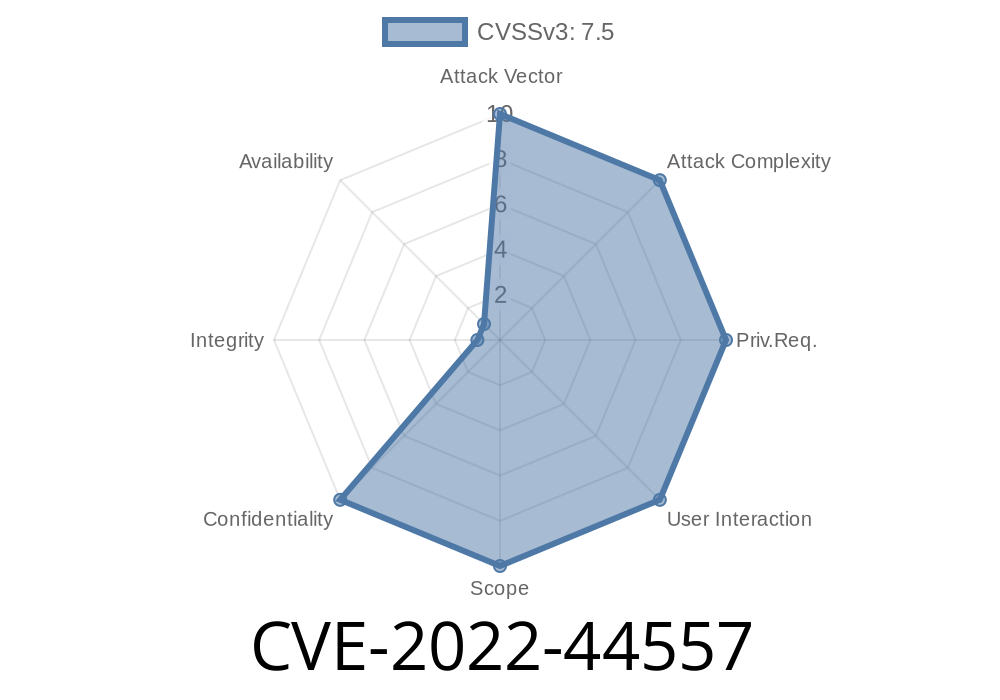A new vulnerability has been discovered in the SmartTrimProcessEvent module, which allows an attacker to gain read and write permissions on arbitrary system files. This vulnerability has been assigned CVE-2022-44557 as its identifier. Successful exploitation of this vulnerability could have dire consequences for data confidentiality and system security.
In this blog post, we will dive deep into the specifics of this vulnerability, including how it occurs, possible attack scenarios, and steps to mitigate it. Additionally, we will provide code snippets and links to original references for more in-depth analysis.
Vulnerability Details
The SmartTrimProcessEvent module is designed to process specific events on systems. However, there is a flaw in the way it handles file access permissions. This can lead to an attacker obtaining both read and write permissions on arbitrary system files, thereby jeopardizing sensitive data.
The vulnerability affects multiple platforms and is caused by the improper use of the SmartTrimProcessEvent() function which contains an insecure code snippet that introduces the flaw.
Here is a code snippet illustrating the issue
int SmartTrimProcessEvent (const char *filename) {
FILE *file;
char tempname[MAX_PATH];
char buffer[4096];
strncpy(tempname, filename, MAX_PATH - 1);
tempname[MAX_PATH - 1] = '\';
file = fopen(tempname, "r+");
if (!file) {
return -1;
}
while (fgets(buffer, sizeof(buffer), file)) {
// Process events...
}
fclose(file);
return ;
}
In this code snippet, the user-controlled value filename is directly used to open a file with r+ mode which allows for both reading and writing.
Impact
The ability to read and write arbitrary files on a system is a significant security risk. Attackers can exploit this vulnerability to access sensitive information, modify configuration files, or even inject malicious code into the system. Moreover, successful exploitation could lead to potential data breaches or facilitate further system compromise.
The following demonstrates a simplified example of how an attacker could exploit CVE-2022-44557
1. The attacker gains access to the targeted system and locates the vulnerable SmartTrimProcessEvent module
2. The attacker creates a carefully crafted input file containing the target system file name they wish to access
Mitigations
The vendor has released a patched version of the SmartTrimProcessEvent module that addresses the vulnerability. Users should immediately upgrade to the latest version of the module to avoid potential exploitation.
Here are some general recommendations to further mitigate the risk
1. Implement proper input validation to ensure only valid, expected values are accepted for the filename input
References
Details of this vulnerability, as well as proposed patches, can be found in the following original references:
- CVE-2022-44557 Official Record
- Vendor Security Advisory
- NIST National Vulnerability Database (NVD) Entry
Conclusion
CVE-2022-44557 represents a critical security risk due to the potential for unauthorized file access and data breaches. It is crucial for system administrators and developers to understand the vulnerability and take the necessary steps to address it. By being aware of the issue, implementing the appropriate patches, and adhering to security best practices, organizations can substantially reduce their exposure to this potentially devastating exploit.
Timeline
Published on: 11/09/2022 21:15:00 UTC
Last modified on: 11/14/2022 19:10:00 UTC
